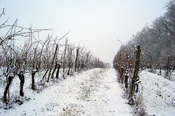By Finger Lakes Correspondent Jason Feulner

This past spring, the comments of some LENNDEVOURS readers concerning the origin of grapes for Dr. Frank’s second label, Salmon Run, elicited a response from Fred Frank, president of the winery. His explanation as to the origin of these grapes for the value-priced Salmon Run line reveals the market pressures that are brought to bear on Finger Lakes wineries. Bad winters can kill some species of vines, creating legitimate regional shortages.
Dr. Frank’s and other quality wineries did face some supply problems over the last several vintages. Luckily, the relative mildness of recent winters and increased plantings have already eased this shortage.
Yet, when does the occasional bad winter explanation give way to the simple fact that some wineries are unable or unwilling to procure locally-grown grapes of certain varietals? Is there any reason for a Finger Lakes winery to continue to produce and market wines that simply do not thrive in a cool growing climate?
I am not implying that it is impossible to grow cabernet sauvignon or merlot in the Finger Lakes and make decent wines from such grapes, but shouldn’t such an accomplishment speak for itself? Wineries with learned and dedicated winemakers will either grow these reds themselves or form relationships with quality growers. In a good vintage, these winemakers will bottle these varietals as stand-alone wines or blend them into carefully crafted meritages. The label says Finger Lakes.
Despite the existence of true Finger Lakes reds, far too many wineries rely on the New York or no appellation label to consistently offer wines that have name recognitio-merlot being the most abused varietal. A few wineries that are well-known and recognized for their general quality are not opposed to offering a merlot that is made predominantly from New York grapes (likely sourced from Long Island).
During a recent tasting at a Cayuga Lake winery, I asked the server if the winery grew any of its own merlot or used local farms. "No, I’m pretty sure it all comes from Long Island," she told me.
I was standing near the shore of Cayuga Lake, not on Long Island or anywhere near it. If I wanted to taste a Long Island merlot, shouldn’t I have purchased one or visited a Long Island winery?
Unfortunately, this practice does not end with the warm-weather reds. A recent scan of a large Syracuse wine retailer with a comprehensive Finger Lakes section revealed a small but significant number of wineries that were using New York grapes, not Finger Lakes grapes, for all kinds of varietals both red and white. A very limited number even use the no AVA designation on their labels at all.
I’m a pragmatic person and I understand that wineries often engage in practices that push a healthy profit. Excess grapes can be purchased more cheaply from certain regions. That’s fine, but I’m curious as to why I should have to sort through 100 different wineries only to find out that a decent number are producing certain wines that have nothing to do with the Finger Lakes. I imagine that the mail delivers grapes and juice anywhere. Some wineries could just as well be located in, well, California.
Wine lovers do not have to be sourcing police, and there are legitimate reasons why the occasional New York designation should find itself on a quality Finger Lakes bottle. Producers should try and limit this practice, however, since it seems hypocritical to promote a region as a wine destination when both the grapes and the people are visitors. Emerging wine regions like the Finger Lakes will find success if they emphasize the unique nature of the wines they grow and produce.
I hope there’s more than a niche market out there for Finger Lakes wineries that want to explore their terrior to its fullest, come success or setbacks.
